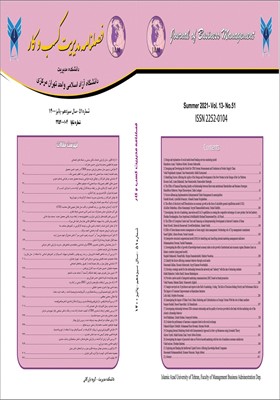تدوین مدل راهبردی جهت رابطه بین دانشگاه وصنعت با هدف جذب دانشجو
محورهای موضوعی : مدیریت کسب و کارمهدی بهاردوست 1 , فریبا حنیفی 2 * , حسن شهرکی پور 3
1 - گروه علوم تربیتی، واحد رودهن، دانشگاه آزاد اسلامی، رودهن، ایران
2 - گروه علوم تربیتی، واحد رودهن، دانشگاه آزاد اسلامی، رودهن، ایران
3 - گروه علوم تربیتی، واحد رودهن، دانشگاه آزاد اسلامی، رودهن، ایران
کلید واژه: دانشگاه, سیاست های جذب دانشجو, "صنعت",
چکیده مقاله :
هدف این مقاله تدوین مدل راهبردی جهت رابطه دانشگاه و"صنعت"با هدف جذب دانشجو می باشد.روش پژوهش آمیخته از نوع اکتشافی بود.جامعه آماری دربخش کیفی شامل سه 20 نفر ازسه گروه1)خبرگان صنعتی؛بهعنوان نمایندۀ بخش صنعت2)مدیران و کارشناسان وزارت صنعت،بهعنوان نمایندۀ بخش دولتی و سیاستگذاری3)روسای دانشگاههاو معاونین واحدهای دانشگاهی و اعضای شورای برنامه ریزی دانشگاه های آزاد،اعضای شورای عالی انقلاب فرهنگی که دارای تجارب و اطلاعات غنیتری درزمینۀ ارتباط دانشگاه با صنعت هستند.رویکردنمونه گیری،هدفمندو روش نمونه گیری صاحبنظران کلیدی بود.ابزار پژوهش،مصاحبه عمیق نیمه ساخت مندبود.دربخش کیفی و درقسمت اول،استخراج داده ها ومولفه ها باروش کدگذاری وروش داده بنیاد می باشدسپس جهت ساخت مدل پژوهش ازمصاحبه باخبرگان وپرسشنامه استفاده شد.الگوی مستخرج از تجزیه وتحلیل یافته های پژوهش درقالب هفت بعد اصلی، و سی پنج معیارطراحی شدهفت بعد اصلی عبارت اند از: عوامل داخل و درون دانشگاهی عوامل خارج و برون دانشگاهی سیاست گذاری وطراحی مجددارتقاءآکادمیکبسترهای قانونیتحولات اساسینهادینه کردندربخش کمی روش تحقیق توصیفی -پیمایشی بودو جامعه آماری شامل31 نفر شامل اساتید دانشگاه آزاد،روسای دانشگاه آزاد و فعالین حوزه صنعت،مدیریت و مسائل جذب دانشجوکه برای اعتباریابی الگو،با استفاده از رویکرد نمونه گیری هدفمند و روش صاحبنظران کلیدی،انتخاب شدند ابزار مورد استفاده در بخش کمی، پرسشنامه محقق ساخته بر اساس شبکه مضامین بخش کیفی بود.
The purpose of this article is to formulate a strategic model for the relationship between university and "industry" with the aim of attracting students.The research method was heuristic.The statistical population in the qualitative section includes three 20 people from three groups:1)industrial experts; Ministry of Industry,as a representative of the public sector and policy-making3)Heads of universities and vice chancellors and members of the Planning Council of Free Universities, members of the Supreme Council of the Cultural Revolution who have richer experiences and information on the university-industry relationship.The research tool was a semi-structured in-depth interview.In the qualitative part and in the first part, data and components are extracted by coding and data method of the foundation. The main dimension,and the thirty-five criteria designed, the main dimensions are:"internal and external factors""external and external factors""policy-making and redesign""academic promotion""legal contexts""fundamental developments""institutionalization" in the section Quantitatively describe the research method The statistical population consisted of 31 people including Azad University professors, Azad University presidents and activists in the field of industry, management and student recruitment issues.To validate the model, using targeted sampling approach and key experts method, tools used in the quantitative section were selected.The researcher-made questionnaire was based on the network of qualitative sections
_||_

